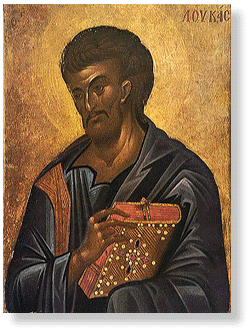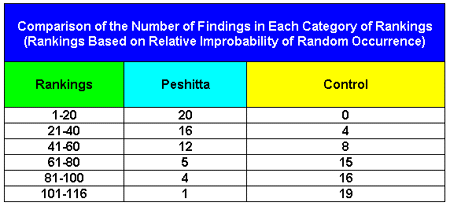| |
Striking Evidence of Intentional Encoding
in the Aramaic New Testament
|
 Extensive new findings by researcher Rev. Glenn David Bauscher of Cambridge, New York provide some of the most striking and statistically significant evidence of encoding yet discovered. The search text is the Aramaic New Testament (Peshitta) and the evidence consists of a series of dramatic mosaics, which are comprised of highly improbable variations from expected in the number of times a given ELS appears in a text. In this article we will focus entirely on 29 different four-letter-long divine names. Bauscher has also conducted extensive research on mosaics for three-, five- and six-letter-long divine names as well, but space doesn�t allow for presentation of the full range of his research in this issue.
Extensive new findings by researcher Rev. Glenn David Bauscher of Cambridge, New York provide some of the most striking and statistically significant evidence of encoding yet discovered. The search text is the Aramaic New Testament (Peshitta) and the evidence consists of a series of dramatic mosaics, which are comprised of highly improbable variations from expected in the number of times a given ELS appears in a text. In this article we will focus entirely on 29 different four-letter-long divine names. Bauscher has also conducted extensive research on mosaics for three-, five- and six-letter-long divine names as well, but space doesn�t allow for presentation of the full range of his research in this issue.
In the October 2026 issue we first reported on some quite striking mosaics discovered by researcher Bauscher in the Peshitta. Those mosaics were comprised of highly improbable variations in the number of appearances of three four-letter names of God. In the January, 2026 issue we presented another compelling Bauscher mosaic comprised of occurrences of Yeshu (Jesus) as an ELS in the Peshitta.
For each of the 29 four-letter-long divine names, Bauscher also conducted exactly parallel searches in a scrambled text of the Peshitta provided by researcher Roy Reinhold for Codefinder. The total number of forward and backward occurrences of each of the ELSs were recorded for all skips from 1,000 up to the maximum possible skip size (153,633). In each case a comparison was made between the expected total number of occurrences and the actual number. This provided a set of 58 variations from expected from both the Peshitta and the scrambled (control) text.
For example, the Aramaic equivalent of the Hebrew word for God, Elohim, is Alaha. Alaha appears as an ELS 2,718,407 times in the Peshitta with a positive skip between 1,000 and 153,633. The Alaha ELS appears 135,567 times more often than expected by chance. This is an exceptionally large variation�given how large the expected number of occurrences is, and the inexorable nature of the Law of Large Numbers. That law will cause variations from the expected to be a smaller percentage of the expected as the expected number itself becomes larger. In the case of the Alaha example, the average variation from expected due to chance is 20,386, so the actual variation is 6.65 times greater than that. What this means is that the variation from expected should almost always be less than three times the average variation from expected, or 61,158 (3 x 20,386), and yet it is 135,567, which is dramatically greater.
In the following chart, the ELSs with the most improbable variations from expected are presented in descending order. The relative size of a variation from expected is measured in terms of a �Z Value.� It is the ratio of the actual variation from expected to the average variation from expected that normally occurs.
|

In visually reviewing the above chart, it is immediately obvious that the top of the chart is completely dominated by Peshitta findings. All of the top 28 ELSs with the most improbable Z scores are from the Peshitta text. Furthermore, 44 out of the 50 ELSs with the most improbable Z scores are from the Peshitta text. Conversely, the bottom is heavily populated with findings from the control text. The next table summarizes this.
|

Of the twenty mosaics that are the most improbable, all are from the Peshitta. Of the mosaics that ranked between 21st and 40th in improbability, 16 are from the Peshitta and 4 from the control text.
In the next table we separately sorted all of the Z scores from the Peshitta and from the control text and we took the ratio of the Z scores of the equally ranked Z scores.
|

Several observations can be made about the above table.
- First, the degree of variation exhibited by the Z scores of the four-letter divine names in the control text is much larger than would be expected if those Z scores conformed to a normal distribution (i.e., a bell-shaped curve). This is largely due to the fact that there is often a sizeable correlation between the size and sign of variations from expected for any given ELS over adjacent skip ranges. This is caused by local variations in letter frequencies for different areas of the literal text.
- Second, having 58 Z scores (variations from expected) from a control text provides a clear definition of the degree of variation in Z scores expected by chance.
- Third, typically the Peshitta Z score is 6 to 10 times greater than the corresponding control text Z score�when these Z scores are ranked from the greatest to the smallest. This is very compelling evidence of the existence of intentional encoding, no matter how one goes about estimating the probability of chance occurrence.
Bauscher�s research has provided a dramatic, clear-cut example of a sacred text that conclusively exhibits the deliberate encoding of excess occurrences of several divine names. Clearly further research in this area is indicated, and Bauscher has already been exploring that with many additional interesting findings.
Continue
|
|
 |




